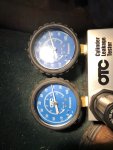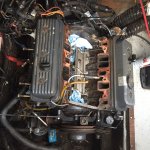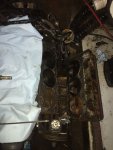Gus-SeaRay
Cadet
- Joined
- Oct 13, 2019
- Messages
- 13
I have a 1999 185 Sea Ray with a 4.3L carbed engine. It is consuming a lot of oil. On a 3 hour outing with some starts and stops a couple of WOT runs for a minute or so the engine consumed a little over 1/2 a quart of oil. I see smoke at start up and after sitting then start up again. Don't notice smoke much when it is in the water. But when on the muffs I can see a little bit of whitish smoke coming out of the exhaust. Also see whitish smoke coming out of the flex pipes that go from the valve cover to the breather. Observed sooty black oil deposit on the outside of the breather where the flex pipes stop. I have done the following test with results.
Compression Test
#6 165
#5 175
#4 173
#3 173
#2 175
#1 178
Re-Tested #6 after seeing it as the low one and got 182 2nd time around.
Leak Down Test. Compressor regulator set at 90psi. 1st number is left gauge on leak down tester / 2nd number is right gauge going to cylinder on tester.
#6 77.5 / 68 = 12.3%
#5 79 / 78 = 1.3%
#4 77 / 67 = 13%
#3 79 / 78 = 1.3%
#2 78 / 71 = 9%
#1 79 / 76 = 4%
Vacuum Test on Manifold
Snap shot attached. This showed good/normal vacuum however with the needle fluttering fast by a small amount.
Some background on the recent findings.
Engine cooling system: I recently replaced the sea water pump, exhaust manifolds and risers because I noticed that the starboard exhaust elbow was getting up to 180+ while the port was running 130 or so. Replaced the engine water pump when I first got it 4 years ago.
--> With a 160deg stat in the boat will not hold a consistent temperature it fluctuates abrubtly between 178 and about 200. Constantly going up and down between 180 and 200.
--> With a 142 deg stat in the boat it holds a consistent temperature at 158 no matter how it is loaded. Stays right there.
Drive/Prop: I have had the boat for 4 seasons and recently realized that the boat likely has had the out drive swapped out because it has a 1.65 gear set and is over propped. WOT is 4000 rpm at 42.6mph on gps.
I have replaced the valve stem seals but really didn't find a difference in the oil consumption... While replacing the valve stem seals I could feel play/wiggle in the stem to guide but each seemed consistent. I did not have a way to measure the movement at the time of replacing the seals.
All that is background at where I am now. I am trying to make a decision about replacing the heads (about $300) or replacing the long block (about $1500).
Questions:
- Am I right in saying based on the compression, leak down and vacuum test that the engine seems healthy?
- I think the tests are pointing to the valve guides being worn. Does it make since that only valve guides would be worn and not the lower end? Or should these be expected to wear at the same rate?
- Is the fact that the engine will not hold consistent temp with a 160 deg stat trump all of the other test and indicate there is something going on in the engine that merits replacing the long block?
- Ultimately should I consider replacing only the heads or should I replace the long block?
Thank you for your time and input!
Gus
Compression Test
#6 165
#5 175
#4 173
#3 173
#2 175
#1 178
Re-Tested #6 after seeing it as the low one and got 182 2nd time around.
Leak Down Test. Compressor regulator set at 90psi. 1st number is left gauge on leak down tester / 2nd number is right gauge going to cylinder on tester.
#6 77.5 / 68 = 12.3%
#5 79 / 78 = 1.3%
#4 77 / 67 = 13%
#3 79 / 78 = 1.3%
#2 78 / 71 = 9%
#1 79 / 76 = 4%
Vacuum Test on Manifold
Snap shot attached. This showed good/normal vacuum however with the needle fluttering fast by a small amount.
Some background on the recent findings.
Engine cooling system: I recently replaced the sea water pump, exhaust manifolds and risers because I noticed that the starboard exhaust elbow was getting up to 180+ while the port was running 130 or so. Replaced the engine water pump when I first got it 4 years ago.
--> With a 160deg stat in the boat will not hold a consistent temperature it fluctuates abrubtly between 178 and about 200. Constantly going up and down between 180 and 200.
--> With a 142 deg stat in the boat it holds a consistent temperature at 158 no matter how it is loaded. Stays right there.
Drive/Prop: I have had the boat for 4 seasons and recently realized that the boat likely has had the out drive swapped out because it has a 1.65 gear set and is over propped. WOT is 4000 rpm at 42.6mph on gps.
I have replaced the valve stem seals but really didn't find a difference in the oil consumption... While replacing the valve stem seals I could feel play/wiggle in the stem to guide but each seemed consistent. I did not have a way to measure the movement at the time of replacing the seals.
All that is background at where I am now. I am trying to make a decision about replacing the heads (about $300) or replacing the long block (about $1500).
Questions:
- Am I right in saying based on the compression, leak down and vacuum test that the engine seems healthy?
- I think the tests are pointing to the valve guides being worn. Does it make since that only valve guides would be worn and not the lower end? Or should these be expected to wear at the same rate?
- Is the fact that the engine will not hold consistent temp with a 160 deg stat trump all of the other test and indicate there is something going on in the engine that merits replacing the long block?
- Ultimately should I consider replacing only the heads or should I replace the long block?
Thank you for your time and input!
Gus






























